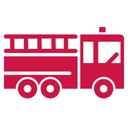All rungs are 1.25" diameter by .065" wall thickness. (Standard
Rung), unless your section width is wider than 24". In this case, you
probably have heavy rungs - 1.25" diameter by .105 wall thickness.
Rung Replacement: It is the
recommendation from the factory that all rungs be replaced when any rung
shows signs of worn/smooth serration's or if any rung is dented, worn
through or damaged in any manner. For a statement from the factory, click here.
All replacement rungs are supplied 24" - standard .065 wall.
To remove any welded rung from the rail or plate, you must use a rung reamer tool.
There is no need to replace the rung plates unless they are damaged.
The reamer tool pilots itself in the rung hole, and cuts only the old
rung away, thereby leaving-the proper size hole for the new rung to be
welded in place. If our standard reamer tool will not fit inside your
rung - be sure the ladder is a Duo-Safety Ladder and check the width of
the section. If the section width is over 24" wide - you have heavy
rungs in that section. Heavy rungs are supplied to meet the NFPA load
rating in all sections wider than 24" wide. In these cases you must
order our Heavy Rung Reamer Tool and heavy rungs for replacements.
The reamer tool is powered by a 1/2" drill. (Fire Dept. Supplies)
- Insert in damaged rung.
- Start drill and use very slight pressure to start the cut.
- Cut through the weld and inner plate crimp to remove the old rung.
- Repeat the process on other rail/plate. (Remove all debris)
- Slide new rung through both rails and mark for length and cut same with hack saw.
- Hold rung flush and reweld the joint. (We suggest Heli-arch/ wire feed)
- If
you have replaced more than 3 rungs per section, we suggest you order
and use our hand rung expander tool to expand the rung to the inner
plates. (Not used on heavy rungs or less than 3 rungs per section.)
Duo-Safety Ladder Corp. ladders all depend 95% on the welded rung
joints to hold all ladders together. The minimum yield of our welded
joint is 8,000 P.S.I.
The expansion process on the inner plates is a 5% back up system to help protect the weld joint from flexing and cracking.
Thus- if you only replace a few rungs per section - you do not need
the expander tool. But if you replace more than 3 rungs per section, we
suggest you use the expander tool.
